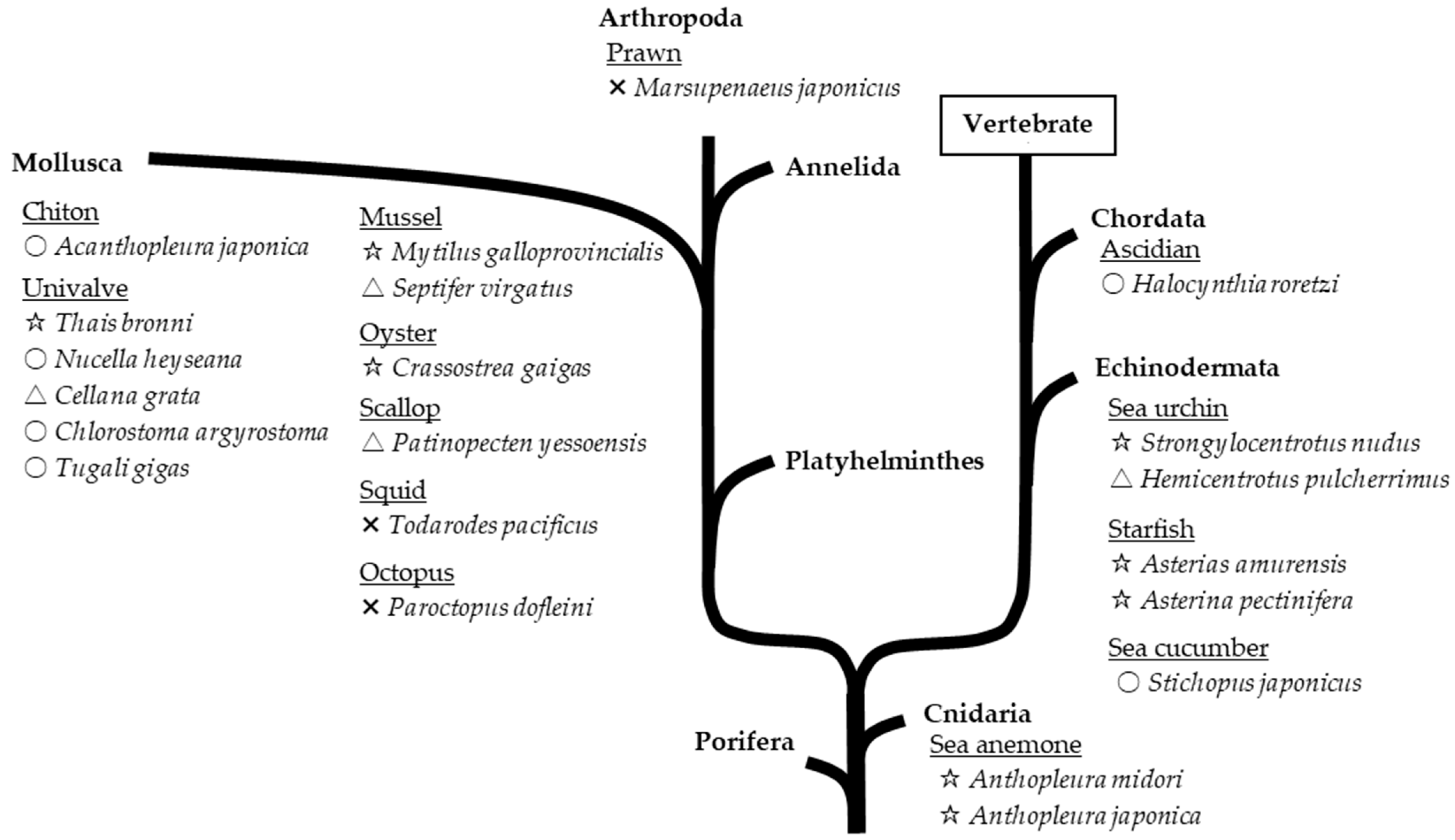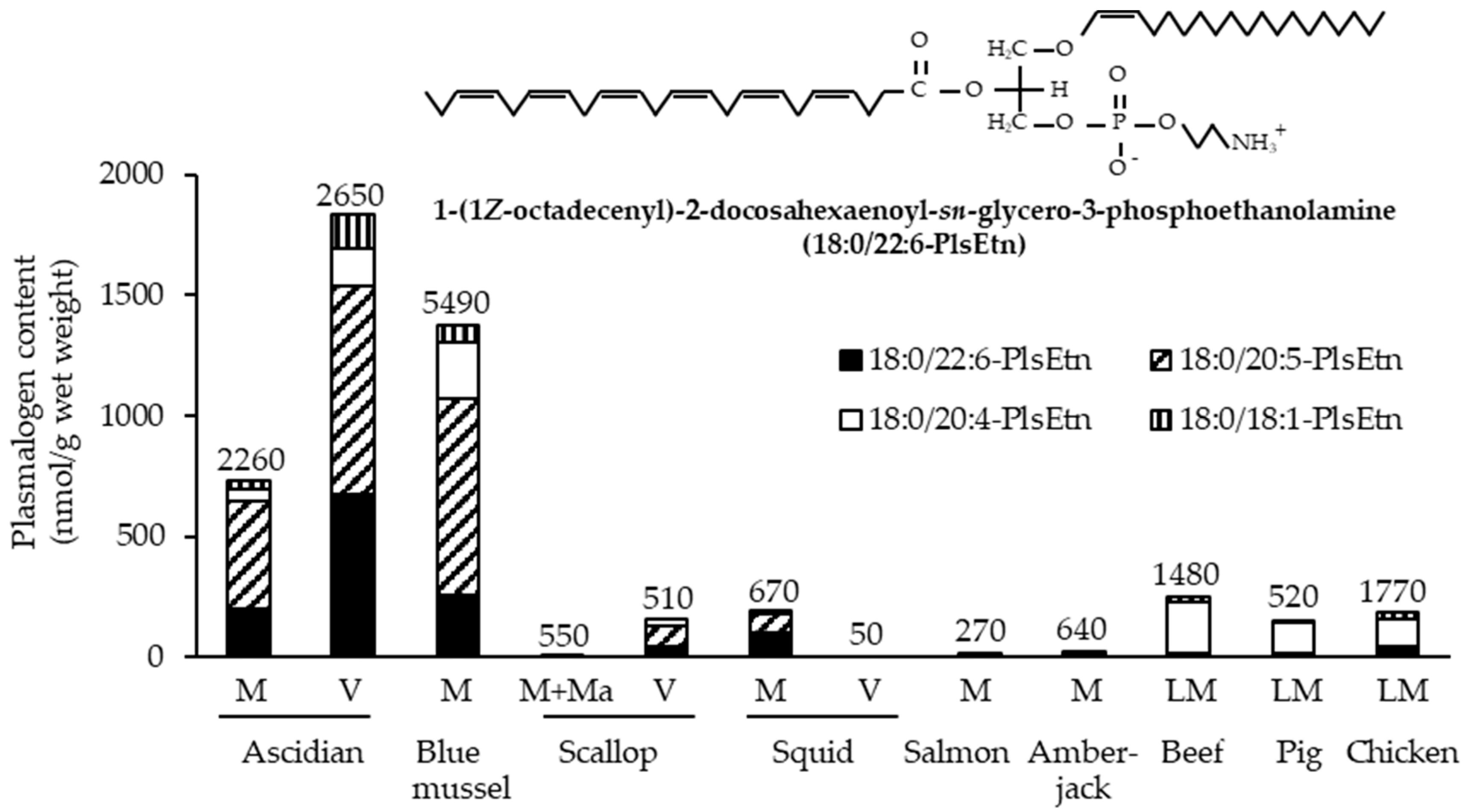Plasmalogens are molecular compounds found mainly in the nervous system of animals. They have specific biochemical properties which makes them particularly beneficial.
Chemically speaking, plasmalogens are glycerophospholipids (GPLs) with a vinyl ether bond at the sn-1 position.
In “Marine Plasmalogens: A Gift from the Sea with Benefits for Age-Associated Diseases”, Yamashita et al (2023) argue how marine resources contain various valuable nutrients including unique plasmalogens which are abundantly found in marine invertebrates such as ascidians. Patients with age-associated diseases such as Alzheimer’s disease have decreased plasmalogen levels.
Supplements prepared from marine invertebrates improve plasmalogen levels in the body, reducing inflammation and improving cognitive function.
Plasmalogens have protective effects on the brain and nervous system in general. In some marine invertebrates, high concentrations exist in the muscles and viscera because of lower neural differentiation than that in vertebrates. That is, the nervous system exists throughout their bodies since they don’t have a brain like normal people do.
Not only do plasmalogens exhibit endogenous antioxidant activities, they also play a crucial role in biological cell membranes. They strengthen lipid membranes and modify their fluidity in relation to specific cellular functions occurring at any specific time.
Our 50,000,000,000,000 or so cells are coated in fatty cell membranes – which happen to be the interface between the cell and the environment. Information from the environment is transferred to the cell via the cell membrane. The cell membrane (“mem-brain”) monitors the condition of the environment and then sends signals to the genes inside the cell so they can engage cellular mechanisms, which in turn, provide for its survival. Healthy cell membrains are crucial for our health.
Another important aspect to consider is that our genes live inside the cells, and the nutrients that best protect and provide for them are those that are able to cross the fatty cell membrane that encloses the cell, that is, fat-soluble nutrients in animal foods.
Aging is associated with mitochondrial dysfunction that induces chronic oxidative and inflammatory stress. This is why aging synergistically increases the risk of various diseases caused by oxidative and inflammatory stress.
In the human brain, plasmalogen levels peak in middle age and tend to decrease in old age, along with myelin – a protective membrane that wraps around part of certain nerve cells and affects how fast signals travel through those nerve cells. It turns out myelin is rich in plasmalogens. A decrease in plasmalogens reduces oxidative resistance and induces cell membrane dysfunction. As plasmalogen levels go down, neuronal death takes place.
Why Ascidian Plasmalogens?
The Ascidian (sea squirt) species Halocynthia roretzi also known as sea pineapple for its peculiar shape, is one of the richest sources of plasmalogens in the marine world. It is mostly consumed in Korea where it is known as meongge, and in Japan, where it is known as hoya or maboya.
Ascidians have been cultured and used as food for its health benefits for many years. It contains various active molecules and some studies have identified up to 950 chemical compounds from which 11 molecules have blood glucose and cholesterol regulating properties. Some of these include rich concentrations of unsaturated fatty acids such as docosahexaenoic acid (DHA) and eicosapentaenoic acid (EPA), also known as Omega-3 fatty acids which are crucial for cardiovascular and cognitive health.
DHA (Omega-3) is the fatty acid that makes up the highest percentage of the human brain, mainly in the grey matter where our thinking takes place. DHA aids visual and cognitive function, forming receptors for feel-good brain chemicals such as serotonin and dopamine. It also helps the hippocampus – our brain’s memory headquarters – make new memories.
DHA is released from plasmalogens in conditions of oxidative stress and inflammation. The phospholipids form of DHA, as the one present in our Ascidians, can cross the blood-brain barrier at a rate of approximately 10 times faster than that of the free fatty acid form of DHA (Watanabe et al. 2020). Therefore, the ingestion of plasmalogens with DHA enhances neuroprotective functions in the brain. These findings suggest that plasmalogens from ascidians might exhibit more potent neuroprotective effects. Ascidian plasmalogens have 33% phospholipids, 23% plasmalogens and the fatty acids of plasmalogens are mainly EPA, DHA, oleic acid and arachidonic acid. (Watanabe et al. 2020)
Other molecules found in ascidians include astaxanthin, one of the most powerful marine-derived antioxidants, which has been reported to prevent diet-induced insulin resistance and fatty liver by improving insulin sensitivity and optimizing fat metabolism. Not only that, some data suggests that astaxanthin reduces lung inflammation and scarring (fibrosis), and it stimulates the innate immune system. (Zhu et al., 2022)
We outsource our Ascidian plasmalogen from Tokyo, Japan, whose purity and plasmalogen content are verified by test analysis of pharmaceutical quality.
More Beneficial Effects
Healthy Japanese adults, ages 45.6 ±11 years had a significantly increased score in composite memory, defined as the sum of verbal and visual memory scores, with only 1 mg of Ascidian plasmalogens.
Visual memory is the ability to recognize, memorize, and recall figures and process graphics and spatial expression. In general, recollection of previous personal experiences constitutes spatial memory. Thus improvement in spatial memory leads to less forgetfulness. Verbal memory is the ability to recognize, memorize, and recall words or letters and reflects the processing ability of character representation and meaning. Consumption of ascidian-derived plasmalogens slowed the progression of forgetfulness in middle-aged people, even in younger people (age > 20 years). Ascidian plasmalogens have been tested and proved beneficial not only in middle-aged and the elderly, but also in all subjects of all ages in the study (Watanabe et al. 2020).
Plasmalogens containing DHA were reported to show neuroprotective effects independent of the DHA content, in fact, the role plasmalogens have in improving cognitive function is considered dominant over DHA.
Marine food resources contain nutrients not found in land or vegetable resources. Other than DHA and EPA, algae-derived xantophylls, including fucoxanthin and astaxanthin, have been reported to exhibit antioxidant and other crucial functions.
Alzheimer’s Disease (AD)
One of the pathological characteristics of AD is the progressive aggregation and accumulation of Aβ peptide in the senile plaques of the human brain. Brain Aβ, is highly neurotoxic, particularly its fibril form. The progressive aggregation of Aβ is a critical step in AD pathogenesis. Aging promotes chronic inflammation and Aβ accumulation.
Plasmalogens levels are low in AD, specifically in the brain and serum, and it’s correlated with the severity of the disease, particularly plasmalogen with DHA. What is more, plasmalogen bearing DHA suppresses the formation and disruption of Aβ fibrils.
Parkinson’s disease (PD)
Plasmalogen levels are also significantly lower in patients with PD, which explains a reduction in cell membrane strength which then affects signal transduction across membranes. Low plasmalogen levels rich in PUFAs may induce impairment of brain blood flow which has been observed in patients with PD.
Arteriosclerosis
Chronic inflammation and dysfunction of lipid metabolism are the main features of aging. This leads to arteriosclerosis and cardiovascular disease. Plasmalogens stabilize LDL against oxidation, a process that is dependent on plasmalogen content. Patients with high triglycerides and cholesterol, have lower plasmalogen levels than healthy subjects.
Patients with coronary artery disease – whether strokes or heart attacks – have lower plasma levels of plasmalogens in their blood. Reduced levels of plasmalogens reduce our resilience to environmental stressors.
Plasmalogens rich in DHA and EPA lessen atherosclerotic lesions and fatty liver by downregulating fat genes and upregulating genes that promote bile acid formation and blood lipids bearing PUFAS within them. Thus, plasmalogens are responsible for the resistance to oxidation found in the vascular endothelium and the liver sterol metabolism, acting as anti-oxidants and LDL modulators in the arterial blood vessels to prevent the formation of atherosclerosis.
The complex molecular structures in plasmalogens from marine sources bearing EPA fatty acids, are essential to suppress arteriosclerosis.
Digestive problems
The digestive system is intrinsically connected with the immune and nervous system, other than its essential function as an organ of digestion, absorption of nutrients and water. We see younger people with functional problems such as inflammatory bowel disease which is more a dietary and lifestyle problem, more than aging itself. Although the latter is also a factor. Plasmalogens play an important role in protecting the digestive lining from developing precancerous polyps.
Marine plasmalogens suppress the formation of intestinal inflammation and its associated microscopic changes in the lining. Ascidian-derived plasmalogens lessen oxidative damage and inflammatory stress in the colon induced by external toxins in animal models. In vitro, models have shown that ascidian-derived plasmalogens inhibit inflammation induced by bacterial toxins such as LPS, protecting thus intestinal cells.
Furthermore, plasmalogens improve colon levels of short-chain fatty acids (prebiotics) and parameters of intestinal health, which are essential to feed the good microbiome in our guts.
Marine plasmalogens perform better on intestinal inflammation caused by aging and other factors, and these beneficial effects in the gut are specific to plasmalogens bearing DHA and EPA.
Cancer
There are many pathological changes in cancer patients including DNA damage, apoptosis, dedifferentiation (cancer cells become immortal at the expense of the patient), dysregulation of cell homeostasis, but at the core, they are all caused by aged-induced inflammation and environmental factors.
Patients with pancreatic cancer exhibited lower levels of plasmalogens than normal subjects. In animal models, plasmalogens decrease the spread and dissemination of lung cancer in mice (Yamashita et al., 2020)
Sea Pineapple – A Gift from the Sea
To avoid Mad Cow Disease issues when you use the brains and central nervous systems of mammals as resources for supplements, marine invertebrates come as a solution. Not only do they show lower neural differentiation than mammals, i.e. their tissues don’t look or form a brain per se, but also they contain higher levels of plasmalogens.
Edible parts of ascidians have a higher ratio of plasmalogens than mammalian brains (> 65 mol%). Moreover, plasmalogens from marine invertebrates are abundant in DHA and EPA. For instance, the plasmalogen-bearing DHA ratio of ascidian muscle and viscera is 9 mol% and 31 mol% of the total plasmalogen, respectively, whereas the ratio of beef (leg muscle), pig and chicken is less than 1 mol% (Yamashita et al., 2020).
This is mother nature’s gift to humanity, a crucial nutrient that is not found in plants and fungi, making it a valuable resource in our fight against inflammation and age-related diseases.

As you can see from the figure above taken from (Yamashita et al., 2020), Ascidian (Halocynthia roretzi) contains one of the highest ratios of plasmalogens in the phylogenetic tree of marine invertebrates with 80-90 mol%.

The second figure shows the composition of plasmalogen species from various food sources. The numbers on the bars show the total plasmalogen content (nmol/g wet weight) in muscle (M) and viscera (V). Again, Ascidian is superior to mussels, scallops or standard squid. Salmon, beef, pig and chicken remain far behind (Yamashita et al., 2020).
Why Supplement Nanoencapsulated and Liposomal Ascidian Plasmalogens?
On the plus side and contrary to popular belief that plasmalogens get degraded by stomach acid, plasmalogens contained in diets are hardly degraded because of the buffering action of the diets.
Unfortunately, the accessibility to Ascidian is limited in the Western world and its taste, described as iodine-like, is not something that is traditionally appreciated by most people.
Furthermore, plasmalogens easily go into degradation and oxidation with storage and high temperatures such as when frying or roasting, and less with boiling.
In the intestines, plasmalogens containing PUFAs are readily transferred from plasma to cells and organs.
Ascidian-derived plasmalogens improve memory function in people with mild cognitive decline and mild forgetfulness. Whereas Omega 3s (DHA and EPA) supplementation attenuate symptoms of mild cognitive decline as seen in Alzheimer’s disease and Parkinson’s disease, plasmalogens and supplements like phosphatidylcholine and phosphatidylserine are reported to improve the cognitive impairment seen in people with cerebrovascular disease (i.e. strokes) and cognitive memory impairment.
Brain inflammation induced by Aβ accumulation, lipopolysaccharides (bacterial toxins), and an unhealthy diet reduces plasmalogen levels in the body which then leads to suppression of neuroregeneration by reducing the expression of the brain-derived neurotrophic factor (BDNF) otherwise known as the brain’s super fertilizer. Less plasmalogens in the body also promotes neuronal death by raising the expression of p75 neurotrophin receptor (p75NTR) and protein kinase Cδ (PKCδ). Marine plasmalogens suppress the accumulation of brain toxins such as Aβ accumulation and other pro-inflammatory brain molecules, thus reducing brain inflammation.
From the various animal sources of plasmalogens, marine sources enhance memory function better, and as we saw above, it might be because marine plasmalogens are richer in DHA and EPA and other healthy molecules such asthanxantin found in Ascidians, conferring greater neuroprotective effects.
Marine plasmalogens correlate with stronger suppressive effects on brain inflammation, neural death, and Aβ accumulation than any other species. Small-sized liposomes or nanoencapsulation can deliver plasmalogens to the brain through the blood-brain barrier readily and this is one of the main reasons why supplementing is the best choice.

Plasmalogen precursors, available in the market today, increase plasma levels of plasmalogens but they do not significantly increase brain levels of plasmalogens and/or pass through the blood-brain barrier, rather, it does so in very small quantities.
Plasmalogen supplementation, particularly marine sources rich in DHA and EPA, improves cognitive functions and reduces their decline with aging, it also helps to reduce inflammation in the entire body.
Further reading
Watanabe, H., Okawara, M., Matahira, Y., Mano, T., Wada, T., Suzuki, N., & Takara, T. (2020). The impact of ascidian (halocynthia roretzi)-derived plasmalogen on cognitive function in healthy humans: A randomized, double-blind, placebo-controlled trial. Journal of Oleo Science, 69(12), 1597–1607. doi:10.5650/jos.ess20167
Yamashita, S., Miyazawa, T., Higuchi, O., Kinoshita, M., & Miyazawa, T. (2023). Marine plasmalogens: A gift from the sea with benefits for age-associated diseases. Molecules, 28(17), 6328. doi:10.3390/molecules28176328
Zhu, Y., Gao, H., Han, S., Li, J., Wen, Q., & Dong, B. (2022). Antidiabetic activity and metabolite profiles of Ascidian Halocynthia roretzi. Journal of Functional Foods, 93, 105095. doi:10.1016/j.jff.2022.105095
